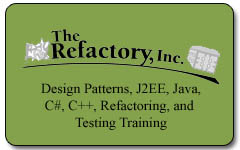OOPSLA ’99
Organizers:
- Joseph W. Yoder
(The Refactory Inc.)
Michel Tilman (Unisys)
Dirk Riehle (Ubilab, Union Bank of Switzerland)
Description
- The unrelenting pace of change that confronts contemporary software developers compels them to make their applications more configurable, flexible, and adaptable. The era where business rules are buried in Cobol code is coming to an end. Today, users themselves may seek to dynamically change their business rules. Customers require systems that more easily adapt to changing business needs, meet their unique requirements, and scale to large and small installations. Multi-tiered systems often demand that data that move through them carry with them their own descriptions. There have been a number of successful frameworks and applications implemented and delivered in different areas of industry that use domain specific languages, metadata, and flexible implementation of business rules to address these sorts of needs.
Today, businesses want to buy applications rather than build them. As a consequence, the IT environment of large corporations frequently resembles a wild and vast collection of different off-the-shelf products as well as home-grown applications that all need to be integrated. Metadata-driven application and business model integration can play a major role in making these systems evolve smoothly.
A system with an active object-model has an explicit object model that it interprets at run-time. If you change the object model, the system changes its behavior. For example, a lot of workflow systems have an active object-model. Objects have states and respond to events by changing state. The active object-model (a.k.a. knowledge level) defines the objects, their states, the events, and the conditions under which an object changes state. Suitably privileged people can change this object model “without programming”. Or are they programming after all? Business rules can be stored in an active object model that makes it easy to evolve the way a company does their business.
Researchers working with reflection and meta-level architectures have been looking at how to make systems highly configurable for quite some time as well. We hope to encourage such researchers to compare notes with practitioners who have been building highly configurable systems in industry.
Our goal is to document the techniques and principles that make these systems work. We hope to “mine” these systems and produce a preliminary collection of metadata and active object-system patterns, and help establish a shared vocabulary.
Requirements
Submission guidelines have expired.
Attendees
This is a list of the people who plan on attending the OOPLSA Workshop.
- Ali Arsanjani AArsanjani@aol.com
- Desmond Dsouza desmond.dsouza@platinum.com
- Michael C. Feathers feathers@icanect.net
- Ed Fernandez ed@cse.fau.edu
- Brian Foote foote@laputan.org
- Martin Fowler fowler@acm.org
- Jeff Gray jgray@vuse.vanderbilt.edu
- Bob Hartwig hartwig@ais.net
- Jeong Ah Kim clara@mail.kwandong.ac.kr
- Holger Knublauch knublauc@faw.uni-ulm.de
- Daniel LaLiberte liberte@w3.org
- Donald Malcolm MacQueen dmacq@erols.com
- Dragos-Anton Manolescu dragos.manolescu@acm.org
- Augustin Mrazik amr@whitestein.com
- Richard McClatchey richard.mcclatchey@cern.ch
- Pablo Nasute nasute_pablo@jpmorgan.com
- Luis Ramos ramos@odi.com
- Reza RAZAVI razavi@poleia.lip6.fr
- Dirk Riehle riehle@acm.org
- Benny Sadeh sadehb@ix.netcom.com
- Michel Tilman mtilman@acm.org
- Glenn Wong glenn.wong@ingenix.com
- Bobby Woolf woolf@acm.org
- Joseph Yoder joeyoder@joeyoder.com I’m still updating this….use the group mailing below.Group Mailing
When:
- The workshop was held on: Tuesday – November 2, 1999.
Position Papers:
Relevant Links:
